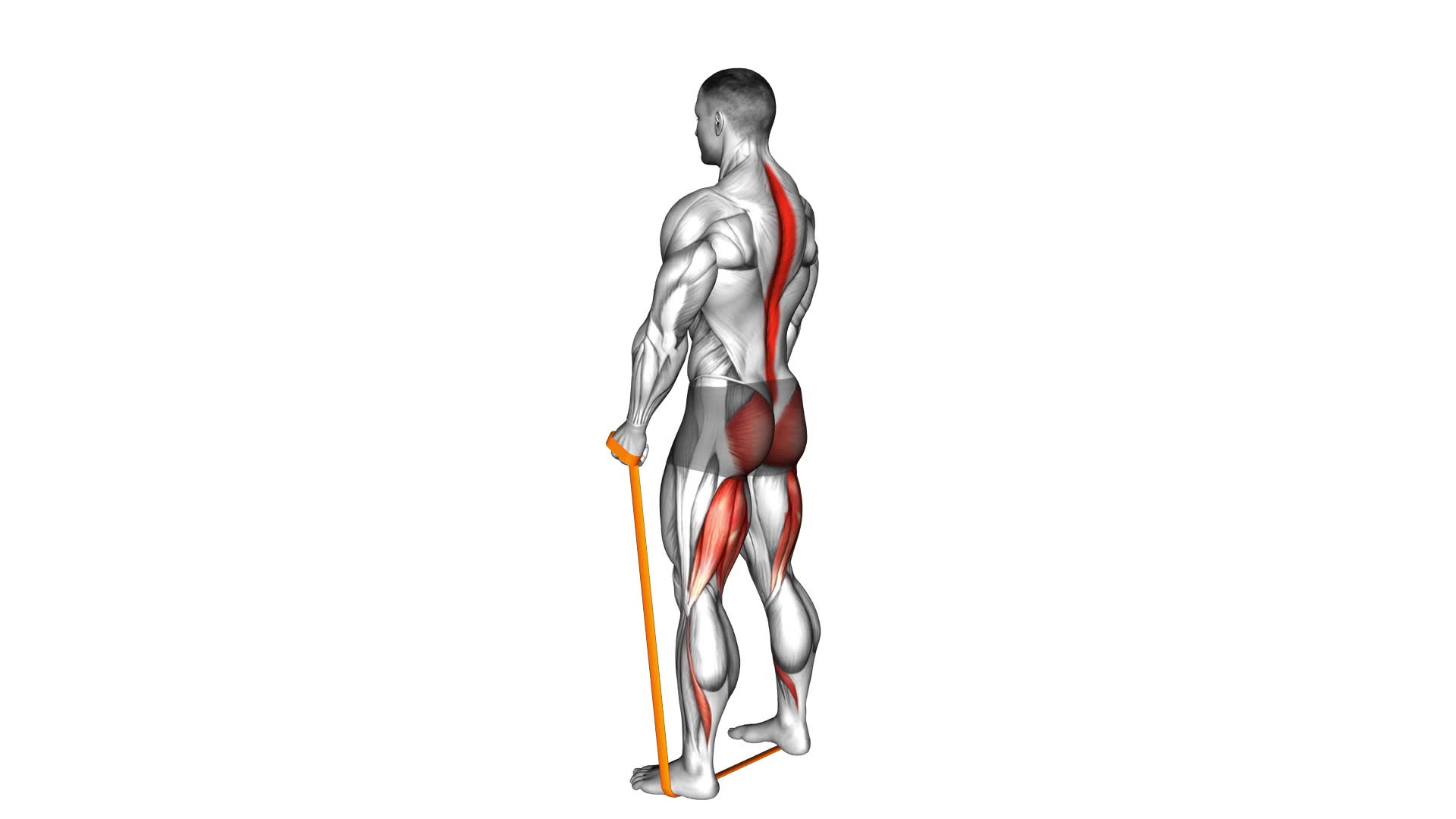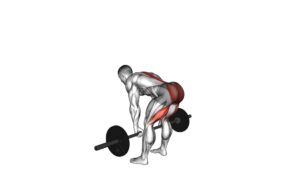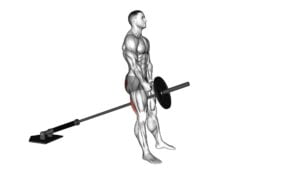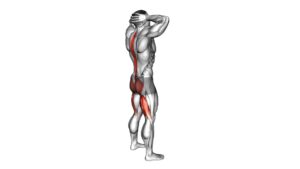Resistance Band Romanian Deadlift – Video Exercise Guide & Tips

Are you looking for an effective exercise to target your hamstrings and glutes? Look no further than the resistance band Romanian deadlift!
Watch This Exercise Video
This video exercise guide and tips article will provide you with all the information you need to perform this exercise correctly.
Learn about the benefits, proper form, common mistakes to avoid, and progression options for this challenging workout.
Get ready to take your lower body strength and stability to the next level with the resistance band Romanian deadlift.
Key Takeaways
- Resistance band Romanian deadlifts strengthen the lower body and improve overall fitness.
- Using resistance bands increases muscle activation and improves flexibility.
- Resistance band Romanian deadlifts activate smaller stabilizer muscles, enhancing strength and stability.
- Proper form and technique, such as focusing on hip hinge movement and engaging the core, are crucial for effective resistance band Romanian deadlifts.
Benefits of Resistance Band Romanian Deadlifts
Experience the numerous benefits of resistance band Romanian deadlifts to strengthen your lower body and improve your overall fitness. Resistance bands offer a unique advantage in resistance training, allowing for increased muscle activation and improved flexibility. By incorporating resistance bands into your Romanian deadlifts, you can target specific muscle groups more effectively, leading to enhanced strength and stability.
One of the key benefits of resistance band exercises, including the Romanian deadlift, is the ability to activate smaller stabilizer muscles that may be neglected during traditional weightlifting exercises. The resistance bands provide constant tension throughout the movement, forcing your muscles to work harder and engage more fibers. This increased muscle activation not only promotes muscular strength, but also improves joint stability and reduces the risk of injuries.
Additionally, resistance band Romanian deadlifts are a great way to improve flexibility. As you bend forward and lower the weights, the resistance bands provide a gentle pull, stretching your hamstrings, glutes, and lower back. This stretching action helps to increase your range of motion and improve overall flexibility.
To maximize the benefits of resistance band Romanian deadlifts, make sure to choose the appropriate resistance band for your fitness level. Start with a lighter band and gradually increase the resistance as your strength improves. Focus on maintaining proper form throughout the exercise, keeping your back flat and core engaged.
Proper Form and Technique for Resistance Band Romanian Deadlifts
To perform the resistance band Romanian deadlift with proper form and technique, it's important to focus on the hip hinge movement.
Engage your core, keep your back straight, and push your hips back as you lower the weights.
Avoid common form mistakes such as rounding your back or bending your knees too much, as this can lead to injury and prevent you from fully engaging the targeted muscles.
Hip Hinge Technique Importance
Mastering the hip hinge technique is crucial for performing resistance band Romanian deadlifts with proper form and technique. The hip hinge is a fundamental movement pattern that involves bending at the hips while maintaining a neutral spine. It's important because it helps engage the posterior chain muscles, including the hamstrings, glutes, and lower back, which are the primary muscles targeted in the Romanian deadlift exercise.
By mastering the hip hinge technique, you can maximize the benefits of the resistance band Romanian deadlift. This includes improving hip mobility, increasing hamstring and glute strength, enhancing core stability, and promoting better posture.
There are also various hip hinge variations, such as the kettlebell swing and barbell hip thrust, which can be incorporated into your training routine to further challenge and strengthen the hip hinge movement pattern.
Common Form Mistakes
To avoid common form mistakes, focus on maintaining proper form and technique during resistance band Romanian deadlifts. Here are some important tips to help you avoid injuries and make modifications for beginners:
- Keep your back straight and engage your core throughout the movement.
- Avoid rounding your shoulders or hunching forward.
- Make sure your knees are slightly bent and tracking in line with your toes.
By following these guidelines, you can ensure that you're performing the resistance band Romanian deadlift with proper form and technique. This won't only help you avoid injuries but also allow you to maximize the benefits of this exercise.
Remember to start with lighter resistance bands and gradually increase the difficulty as you become more comfortable with the movement.
Choosing the Right Resistance Band for Your Fitness Level
Before beginning your resistance band Romanian deadlift routine, it's important to choose the right resistance band for your fitness level. Selecting the appropriate band will ensure that you're able to perform the exercise safely and effectively.
Resistance bands offer a multitude of benefits for your fitness routine. They provide constant tension throughout the movement, which helps to activate and strengthen your muscles. Additionally, using resistance bands can improve your flexibility and range of motion, making it an ideal tool for the Romanian deadlift.
To determine the right resistance band for your fitness level, consider your current strength and experience. If you're a beginner or have limited strength, start with a lighter resistance band. This will allow you to focus on mastering the proper technique without compromising your form. As you progress and become more comfortable with the exercise, you can gradually increase the resistance of the band to continue challenging your muscles.
It is important to note that proper resistance band technique is crucial to prevent injury and maximize results. Ensure that the band is securely anchored and that you maintain proper posture throughout the exercise. Engage your core, hinge at the hips, and keep your back straight as you perform the Romanian deadlift.
Common Mistakes to Avoid During Resistance Band Romanian Deadlifts
To perform resistance band Romanian deadlifts correctly and avoid common mistakes, there are two key points to keep in mind.
First, focus on maintaining balance throughout the movement by keeping your core engaged and your weight evenly distributed between both feet.
Second, ensure proper band placement by securely anchoring the band under your feet and holding onto the handles with a firm grip.
Balance and Form Tips
Maintain proper balance and form by engaging your core and keeping your spine neutral during resistance band Romanian deadlifts. This will help you maximize muscle activation and minimize the risk of injury.
Here are some tips to ensure you maintain the correct balance and form:
- Keep your feet shoulder-width apart and distribute your weight evenly on both feet.
- Engage your core by pulling your belly button towards your spine.
- Maintain a neutral spine throughout the movement by avoiding excessive rounding or arching.
By following these tips, you'll improve your balance and stability, allowing you to target the intended muscles effectively.
Proper Band Placement
Ensure proper band placement during resistance band Romanian deadlifts by positioning the band securely around your feet. This is crucial for maintaining band tension throughout the exercise and maximizing its effectiveness. Start by placing the band flat on the floor and step on it with both feet, making sure it's centered under the arches.
Keep your feet shoulder-width apart and toes pointing forward. Make sure the band is snug and not slipping or sliding during the movement. This will help maintain the desired resistance and prevent any unnecessary strain on your lower back.
Progression and Variations for Resistance Band Romanian Deadlifts
As you progress with resistance band Romanian deadlifts, you can incorporate variations to challenge your muscles and enhance your workout. Here are some progression options and variations you can try:
- Single-leg Romanian deadlifts: Stand on one leg while performing the exercise to increase the difficulty and engage your core muscles even more.
- Sumo Romanian deadlifts: Widen your stance and turn your toes outwards to target your inner thighs and glutes.
- Eccentric Romanian deadlifts: Slow down the lowering phase of the exercise to increase time under tension and further strengthen your muscles.
These variations not only help you target different muscle groups but also add variety to your routine, preventing plateaus and keeping your workouts interesting. By challenging your muscles in new ways, you can continue to make progress and see improvements in strength and stability.
Now that you know about different progression options and variations for resistance band Romanian deadlifts, let's move on to some tips for getting the most out of your workouts.
Tips for Getting the Most Out of Your Resistance Band Romanian Deadlifts
To maximize the effectiveness of your resistance band Romanian deadlifts, focus on proper form and technique. By doing so, you can ensure that you aren't only getting stronger but also preventing injuries.
Here are some tips to help you get the most out of your resistance band Romanian deadlifts:
- Start with the right resistance band: Use a band that provides enough tension to challenge your muscles without compromising your form. This will help you build strength effectively.
- Maintain a neutral spine: Keep your back straight throughout the movement. Avoid rounding or arching your back, as this can strain your lower back and increase the risk of injury.
- Engage your core: Before you start the movement, activate your core muscles by pulling your belly button towards your spine. This will provide stability and support during the exercise.
- Control the movement: Lower the weights slowly and with control. Avoid using momentum to lift the weights, as this can diminish the effectiveness of the exercise and increase the risk of injury.
- Focus on the hip hinge: The Romanian deadlift is a hip-dominant exercise, so make sure to hinge at the hips while keeping your knees slightly bent. This will target your glutes and hamstrings effectively.
Frequently Asked Questions
How Long Should I Hold the Resistance Band Romanian Deadlift Position?
To properly perform a resistance band Romanian deadlift, it's important to know how long to hold the position. Without context, the ideal duration can vary.
However, a general guideline is to hold the position for a brief pause at the bottom of the movement, just before returning to the starting position. This allows for maximum engagement of the targeted muscles and ensures proper form.
Avoid common mistakes like rounding your back or using too much momentum.
Can Resistance Band Romanian Deadlifts Help Improve Flexibility?
Resistance band Romanian deadlifts can definitely help improve your flexibility, especially in your hamstrings. By incorporating resistance bands into your deadlifts, you add an extra challenge to the exercise, which can lead to increased strength and range of motion in your hamstrings.
This type of training is known to have many benefits, including improved muscle activation, stability, and overall strength. So, if you're looking to enhance your hamstring flexibility, resistance band Romanian deadlifts are a great exercise to incorporate into your routine.
Are There Any Modifications for Individuals With Lower Back Pain?
If you're dealing with lower back pain, there are modifications you can make to the resistance band Romanian deadlift exercise. These modifications can help protect your lower back while still reaping the benefits of the exercise.
By using a lighter resistance band or reducing the range of motion, you can decrease the strain on your lower back.
It's important to listen to your body and consult with a healthcare professional before attempting any modifications or new exercises.
How Frequently Should Resistance Band Romanian Deadlifts Be Performed?
Resistance band Romanian deadlifts can be a valuable addition to your workout routine. These deadlifts offer numerous benefits, such as strengthening your posterior chain and improving hip mobility. By incorporating resistance bands, you'll also increase the resistance and challenge your muscles even more. When it comes to frequency, aim to perform this exercise 2-3 times a week for optimal results. Remember to maintain proper form and gradually increase the intensity to avoid injury.
Can Resistance Band Romanian Deadlifts Be Done Without a Resistance Band?
Resistance band Romanian deadlifts can be done without a resistance band, but using one provides additional benefits. If you don't have access to a resistance band, you can try alternative exercises like dumbbell or barbell Romanian deadlifts.
However, resistance bands offer variable tension throughout the movement, which can help improve strength and stability. They also provide constant resistance, making the exercise more challenging. Incorporating resistance bands into your deadlifts can amplify your workout and target your muscles in a different way.
Conclusion
In conclusion, resistance band Romanian deadlifts are a highly effective exercise for strengthening your lower body and improving your overall fitness. By using the proper form and technique, choosing the right resistance band for your fitness level, and avoiding common mistakes, you can maximize the benefits of this exercise.
Additionally, progressing and varying your resistance band Romanian deadlifts will keep challenging your muscles and prevent plateauing.
Remember to follow these tips to get the most out of your workouts and achieve your fitness goals.

Author
Years ago, the spark of my life’s passion ignited in my mind the moment I stepped into the local gym for the first time. The inaugural bead of perspiration, the initial endeavor, the very first surge of endorphins, and a sense of pride that washed over me post-workout marked the beginning of my deep-seated interest in strength sports, fitness, and sports nutrition. This very curiosity blossomed rapidly into a profound fascination, propelling me to earn a Master’s degree in Physical Education from the Academy of Physical Education in Krakow, followed by a Sports Manager diploma from the Jagiellonian University. My journey of growth led me to gain more specialized qualifications, such as being a certified personal trainer with a focus on sports dietetics, a lifeguard, and an instructor for wellness and corrective gymnastics. Theoretical knowledge paired seamlessly with practical experience, reinforcing my belief that the transformation of individuals under my guidance was also a reflection of my personal growth. This belief holds true even today. Each day, I strive to push the boundaries and explore new realms. These realms gently elevate me to greater heights. The unique combination of passion for my field and the continuous quest for growth fuels my drive to break new ground.







